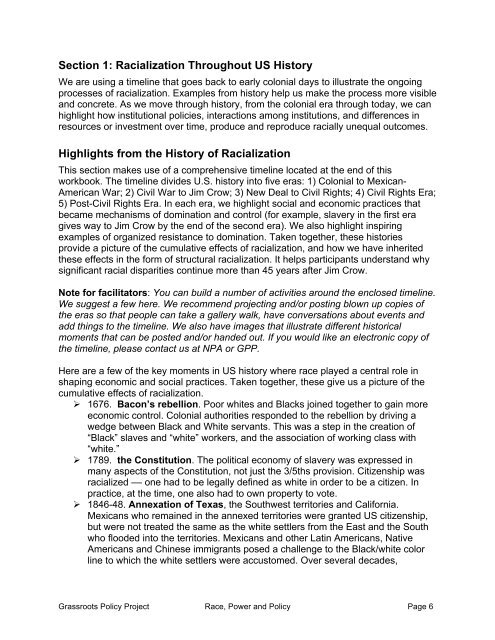Institutional Racism
Institutional Racism
Institutional Racism
Create successful ePaper yourself
Turn your PDF publications into a flip-book with our unique Google optimized e-Paper software.
Section 1: Racialization Throughout US History<br />
We are using a timeline that goes back to early colonial days to illustrate the ongoing<br />
processes of racialization. Examples from history help us make the process more visible<br />
and concrete. As we move through history, from the colonial era through today, we can<br />
highlight how institutional policies, interactions among institutions, and differences in<br />
resources or investment over time, produce and reproduce racially unequal outcomes.<br />
Highlights from the History of Racialization<br />
This section makes use of a comprehensive timeline located at the end of this<br />
workbook. The timeline divides U.S. history into five eras: 1) Colonial to Mexican-<br />
American War; 2) Civil War to Jim Crow; 3) New Deal to Civil Rights; 4) Civil Rights Era;<br />
5) Post-Civil Rights Era. In each era, we highlight social and economic practices that<br />
became mechanisms of domination and control (for example, slavery in the first era<br />
gives way to Jim Crow by the end of the second era). We also highlight inspiring<br />
examples of organized resistance to domination. Taken together, these histories<br />
provide a picture of the cumulative effects of racialization, and how we have inherited<br />
these effects in the form of structural racialization. It helps participants understand why<br />
significant racial disparities continue more than 45 years after Jim Crow.<br />
Note for facilitators: You can build a number of activities around the enclosed timeline.<br />
We suggest a few here. We recommend projecting and/or posting blown up copies of<br />
the eras so that people can take a gallery walk, have conversations about events and<br />
add things to the timeline. We also have images that illustrate different historical<br />
moments that can be posted and/or handed out. If you would like an electronic copy of<br />
the timeline, please contact us at NPA or GPP.<br />
Here are a few of the key moments in US history where race played a central role in<br />
shaping economic and social practices. Taken together, these give us a picture of the<br />
cumulative effects of racialization.<br />
! 1676. Bacon’s rebellion. Poor whites and Blacks joined together to gain more<br />
economic control. Colonial authorities responded to the rebellion by driving a<br />
wedge between Black and White servants. This was a step in the creation of<br />
“Black” slaves and “white” workers, and the association of working class with<br />
“white.”<br />
! 1789. the Constitution. The political economy of slavery was expressed in<br />
many aspects of the Constitution, not just the 3/5ths provision. Citizenship was<br />
racialized –– one had to be legally defined as white in order to be a citizen. In<br />
practice, at the time, one also had to own property to vote.<br />
! 1846-48. Annexation of Texas, the Southwest territories and California.<br />
Mexicans who remained in the annexed territories were granted US citizenship,<br />
but were not treated the same as the white settlers from the East and the South<br />
who flooded into the territories. Mexicans and other Latin Americans, Native<br />
Americans and Chinese immigrants posed a challenge to the Black/white color<br />
line to which the white settlers were accustomed. Over several decades,<br />
Grassroots Policy Project Race, Power and Policy Page 6

















